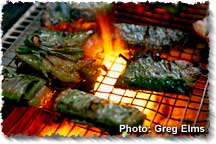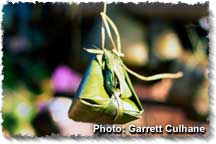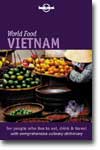
|


Let Us Eat Cake
Story by: Richard Sterling
Photos by: Garrett Culhane and Greg Elms
 anh is a word for
which there is no satisfactory English equivalent. Spring rolls can be called
banh, as can crepes. Sandwiches, and any baked goods are called banh. And sweets
and savories wrapped in leaves to be steamed or grilled are called banh. The
only constant is that banh are small culinary bundles or other constructions,
often eaten with the hands. Vietnamese who speak English generally refer to
them as "cake." You may be asked by some generous host, "Would you like a cake?"
And you might be given a cookie. "Have a cake," the merchant says. And he hands
you what amounts to a sausage roll. But call it what they will, banh are quintessential
street food. anh is a word for
which there is no satisfactory English equivalent. Spring rolls can be called
banh, as can crepes. Sandwiches, and any baked goods are called banh. And sweets
and savories wrapped in leaves to be steamed or grilled are called banh. The
only constant is that banh are small culinary bundles or other constructions,
often eaten with the hands. Vietnamese who speak English generally refer to
them as "cake." You may be asked by some generous host, "Would you like a cake?"
And you might be given a cookie. "Have a cake," the merchant says. And he hands
you what amounts to a sausage roll. But call it what they will, banh are quintessential
street food.
 The
oldest form of banh, indeed what is arguably the world's oldest form of cooking
other than simply exposing meat to fire, are those wrapped in leaves. In every
market, and on street corners of every city and town, you will see them. Tightly
wrapped in green and tied with complex knots that would make a sailor proud,
they fill baskets with their abundance, they sit neatly stacked on counter tops,
and they hang in clusters from eves, cross beams, or stall corners, edible ornaments.
What do they hide within? Why ask? Buy a few. Choose a fat cylinder whose weight
tells you how much of your appetite it will satisfy. Select a few small ones,
little culinary jewels, square, round, triangular. Take them to a shady corner
and sit quietly with them for a moment. Run your fingers over the intricate
lacings that bind them together. Bring them to your nose for a clue to what
might rest within. Strip the lacings off, and unfold them, layer by layer by
yet deeper layer. Like a Russian doll or a dancer with seven veils, it slowly
reveals itself. Is it a sweet rice cake? Perhaps a morsel of spiced ham? It
could be minced pork, or a piece of sweet potato, a savory rice cake, itself
a wrapping for shrimp or mung beans. It could be any tasty thing in the world. The
oldest form of banh, indeed what is arguably the world's oldest form of cooking
other than simply exposing meat to fire, are those wrapped in leaves. In every
market, and on street corners of every city and town, you will see them. Tightly
wrapped in green and tied with complex knots that would make a sailor proud,
they fill baskets with their abundance, they sit neatly stacked on counter tops,
and they hang in clusters from eves, cross beams, or stall corners, edible ornaments.
What do they hide within? Why ask? Buy a few. Choose a fat cylinder whose weight
tells you how much of your appetite it will satisfy. Select a few small ones,
little culinary jewels, square, round, triangular. Take them to a shady corner
and sit quietly with them for a moment. Run your fingers over the intricate
lacings that bind them together. Bring them to your nose for a clue to what
might rest within. Strip the lacings off, and unfold them, layer by layer by
yet deeper layer. Like a Russian doll or a dancer with seven veils, it slowly
reveals itself. Is it a sweet rice cake? Perhaps a morsel of spiced ham? It
could be minced pork, or a piece of sweet potato, a savory rice cake, itself
a wrapping for shrimp or mung beans. It could be any tasty thing in the world.
Each region in Vietnam has its own banh just as each region of France has
its own wine. And the various ethnic groups prepare different types of banh
with their local ingredients. People from the Tay ethnic minority wrap yams
in banana leaves and call it banh khoaiso. Hmong people use banana
leaves to wrap banh ngo non, or young corn banh. Sweet potatoes and cassava
are other common ingredients in the highlands. Leaf wrapped banh are so popular
and enduring because they are so well suited to local materials and conditions.
Leaves provide a container in which foods are cooked, and also help to preserve
the food and keep it from getting dirty or moldy. And it is so compact and portable
that if you have banh, you've always got a movable feast. And no worries about
disposing of a plastic wrapper.
 The
most common ingredient in banh is rice, both sticky and fluffy. A popular type
is, "square cake" known in the north as banh chung. A savory sticky rice
preparation filled with mung bean paste and minced pork, wrapped in banana leaves,
or the leaves of rushes, and steamed. While these can be found any day of the
year, they are also important as festival fare. Legend has it that this recipe
dates back to the time of the Hung kings, the original founders of Vietnam.
Its shape, in keeping with Chinese depictions of Heaven and Earth, is said to
represent Earth. In the central and southern parts of the country this cake
is called banh u. The interior recipe is the same, but the package is
intricately folded into a little pyramid. You can often see these placed on
family altars, especially in farm villages, where they honor "the soul of the
rice." The
most common ingredient in banh is rice, both sticky and fluffy. A popular type
is, "square cake" known in the north as banh chung. A savory sticky rice
preparation filled with mung bean paste and minced pork, wrapped in banana leaves,
or the leaves of rushes, and steamed. While these can be found any day of the
year, they are also important as festival fare. Legend has it that this recipe
dates back to the time of the Hung kings, the original founders of Vietnam.
Its shape, in keeping with Chinese depictions of Heaven and Earth, is said to
represent Earth. In the central and southern parts of the country this cake
is called banh u. The interior recipe is the same, but the package is
intricately folded into a little pyramid. You can often see these placed on
family altars, especially in farm villages, where they honor "the soul of the
rice."
Banh tet, sometimes called banh tay,is said to have been first
prepared by votaries of the Hung temple, near Hanoi. This is sometimes called
the birthplace of the Vietnamese people, and its banh is meant to symbolize
the continuity of the race, its determination to "go forth and multiply." banh
tet is always filled with rice, the gastronomic symbol of fertility, and is
always in the form of a cylinder of a size that fits easily in your hand. Yes,
when you eat this, you eat a Phallic symbol. Honest. But it always comes with
round shaped banh day, the female equivalent. Eat, and multiply.
Banh Gio, a well known treat in the north is made from rice flour and
pork wrapped in banana leaves. These round-shaped things are about the size
of a hamburger. In Hue a similar recipe is used, but the banh are rolled into
long, thin cylinders and are wrapped in dong leaves. These are known as banh
la or banh nam, depending on the thickness of the cylinders.
In Hue you can also find banh it. They are little balls of sticky rice
flour stuffed with shrimp and pork. Tasty morsels, they are served plain or
wrapped in banana leaves. A variation is sometimes called black banh
it. These are sweet rice balls filled with a paste of sweetened mung beans.
In northern Vietnam, people pound a type of leaf known as la gai into sticky
rice flour for banh gai. Now dark in colour from the gai, the banh are
filled with sweetened mung beans and wrapped in banana leaves.
 Like
banh gai, banh com are a speciality of the Red River delta. Green ginger
leaves are used to tint sticky rice which is then filled with sweetened mung
beans. After being cooked, the banh com are wrapped in banana leaves. These
banh are a popular wedding gift among tradition minded people. Like
banh gai, banh com are a speciality of the Red River delta. Green ginger
leaves are used to tint sticky rice which is then filled with sweetened mung
beans. After being cooked, the banh com are wrapped in banana leaves. These
banh are a popular wedding gift among tradition minded people.
Also associated with marriage is su se banh. The original name of these
banh was phu-the, or "husband-wife". The sticky ingredients inside are
said to bind like love. Made of manioc flour, su se banh are colourless that
the filling of copra and mung beans can be seen through the crust, so they will
sometimes be colored red or green with vegetable dye. In northern parts su se
are not wrapped, but in the central region they are wrapped in palm leaves.
As you patrol the streets for treats, keep an eye out for banh tro
or banh gio. These sweet banh incorporate the pits of xoan (Japanese
lily) fruit. These pits are first burned and the ashes are mixed with water
and lime. Rice is then soaked in this mixture and will thicken. After cooking,
enjoy them with a sweet syrup such as molasses or caramel sauce. These are believed
to be good for digestion, Be aware, though, that, like saffron, in higher doses,
the ash of xoan stones is toxic. People of the Tay ethnic minority also prepare
this kind of banh, but they form them into crescent shapes and call it pheng
cooc mo, or "cow horns".
Tasty banh wrapped in lovely green leaves are good for your tummy and good
for the planet and good for your budget. But get your leafy banh while you can,
for "progress" rears its ugly head in Vietnam. In the larger cities we see the
beginnings of a disturbing trend among makers and sellers of banh of replacing
the ancient leaf wrappings with plastic or paper bags. Certain Philistines in
Hanoi have been spotted selling banh com in blue boxes instead of wrapped
in fresh banana leaves. Be watchful of these "innovations." Accept no substitutes.
Go for the green!
This story was excerpted from Lonely Planet World Food Vietnam.
About the Author
 Richard Sterling has been called the "Indiana Jones of Gastronomy"
for his willingness to go anywhere and court danger for the sake of a good meal.
His books include: Richard Sterling has been called the "Indiana Jones of Gastronomy"
for his willingness to go anywhere and court danger for the sake of a good meal.
His books include:
Lonely
Planet World Food: Vietnam
The
Adventure of Food: True Stories of Eating Everything
The Fearless Diner: Travel Tips and Wisdom for Eating Around the World
Richard also writes a monthly column for San Francisco Magazine. When not on the road, Richard can be found in Berkeley California.
|







